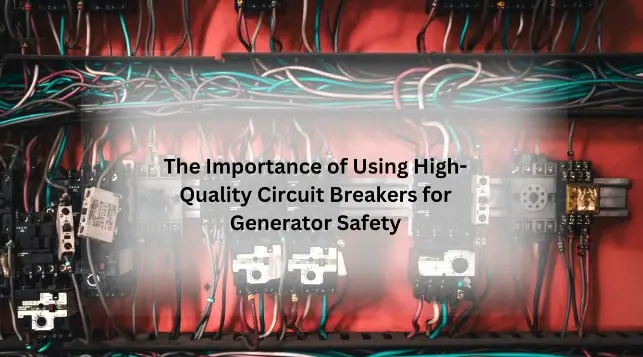As an Amazon Associate, we earn from qualifying purchases. This does not affect the price you pay or the quality of the products you buy. For more information, please read the full affiliate disclosure here.
Are you tired of your electronic devices and appliances getting damaged due to the high voltage from your generator?
Or are you looking for a solution to protect your valuable assets from this constant threat?
If you answered yes to either of these questions, then you are not alone.
High voltage from generators is a common problem that affects many households and businesses.
It damages electronic devices and appliances, causing costly repairs or replacements, which can be a significant source of frustration and stress for those who rely on these devices and appliances for daily activities.
If you are a homeowner or a business owner who has experienced the pain of dealing with damaged electronics due to high generator voltage, then you know the importance of finding a solution to this problem.
In this blog post, we will discuss the various ways you can reduce the voltage in your generator to protect your valuable assets and minimize the frustration and stress caused by high voltage.
Let’s get started!
What Should You Know About Generator Voltage?
Before we dive into the different methods to reduce generator voltage, let’s first understand what generator voltage is.
Generator voltage is the electrical potential difference between two points in a generator’s electrical circuit.
The voltage produced by a generator depends on several factors, such as the number of turns in the generator’s coils, the strength of the magnetic field, and the speed of the rotor.
The spread of the rotor in the generator directly determines the amount of voltage it will produce.
When the rotor spins faster, it produces more voltage, and when it spins slower, it produces less voltage. The voltage produced by a generator is measured in volts (V).
Also Read:- Generator Output Voltage Too High: Troubleshooting Guide
Why Reduce Your Generator Voltage?
As mentioned earlier, generators produce a high voltage that could damage sensitive electronic devices or appliances.
In most cases, electronic devices and appliances are designed to operate within a specific voltage range. If the voltage exceeds this range, it could cause permanent damage to the device or appliance.
Reducing the voltage in a generator is, therefore, essential to ensuring that electronic devices and appliances are protected from damage.
Additionally, reducing the voltage in a generator can also help to reduce energy consumption and fuel consumption, as well as extend the lifespan of the generator.
Also Read:- How to Adjust Generator Voltage: A Step-by-Step Guide
What are the Methods Used to Reduce Generator Voltage?
1. Adjusting the Speed of the Rotor
As mentioned earlier, the voltage produced by a generator is directly proportional to the speed of the rotor. Therefore, one way to reduce the voltage in a generator is to reduce the speed of the rotor. This can be done by adjusting the engine speed of the generator.
Most generators come with a throttle control that allows you to adjust the engine speed. By reducing the engine speed, you can reduce the speed of the rotor, which in turn reduces the voltage produced by the generator.
You must also know that reducing the engine speed too much can also reduce the power output of the generator. So, you must strike a balance between reducing the voltage and maintaining the power output.
But sometimes, no matter how you reduce the speed of your generator, it will still be the same. If that is the case, then the governor control (the part controlling the speed of the engine) is damaged. So you have no choice but to contact a professional.
2. Using Voltage Regulators
Another way to reduce the voltage in a generator is to use voltage regulators. Voltage regulators are electronic devices that help to regulate the voltage produced by a generator. They work by monitoring the voltage output of the generator and adjusting it to a safe level.
Voltage regulators come in different types, such as electromechanical and electronic voltage regulators.
Electromechanical voltage regulators use mechanical components to regulate the voltage, while electronic voltage regulators use electronic components to regulate the voltage.
Electronic voltage regulators are more efficient and reliable than electromechanical voltage regulators. They are also more precise and can regulate the voltage to a more accurate level. However, they are also more expensive than electromechanical voltage regulators.
What you can do in this case is check if they are the ones causing the generator voltage to be high. You can achieve such a reading with the help of a voltmeter. If they are the cause, you should change the voltage regulator.
You can read more about generator voltage regulators here: Understanding Generator Voltage Regulators: Types and How They Work.
3. Using transformers
Transformers are also an effective way to reduce the voltage in a generator. Transformers work by converting high voltage to low voltage or vice versa. To reduce the voltage in a generator, a step-down transformer is used.
A step-down transformer is a transformer that reduces the voltage of the input power. It has more turns in the secondary coil than the primary coil, which helps reduce the voltage. By using a step-down transformer, the voltage produced by the generator can be reduced to a safe level.
Using transformers to reduce generator voltage can also cause a reduction in power output. Therefore, you must use a transformer that is designed to handle the power output of the generator.
3. Using Capacitors
Capacitors are also an effective way to reduce the voltage in a generator. Capacitors are electronic components that store electrical energy. They work by charging up with electrical energy and releasing it when needed.
To reduce the voltage in a generator, capacitors can be used in parallel with the load. When the voltage produced by the generator exceeds the safe level, the capacitors will absorb the excess voltage and release it back into the load when needed.
The use of capacitors to reduce generator voltage is commonly used in small-scale generators like the Tiger 950 generator. However, it is important to note that using capacitors to reduce voltage can also cause a reduction in power output.
You can check if the capacitor is causing the generator voltage to be high by also using a voltmeter, as explained above, to read the capacitor. and if it is, you should change the capacitor.
4. Using Resistors
Lastly, resistors are another way to reduce the voltage in a generator. Resistors are electronic components that resist the flow of electrical current. They work by converting electrical energy into heat.
To reduce the voltage in a generator, resistors can be used in series with the load. When the voltage produced by the generator exceeds the safe level, the resistors will resist the flow of current and reduce the voltage to a safe level.
However, the use of resistors to reduce generator voltage is not very efficient. This is because resistors convert electrical energy into heat, which can be a waste of energy. But you can try other methods.
Factors to Consider When Reducing Generator Voltage
When reducing the voltage of a generator, there are several factors that you need to consider.
These factors include:
- Load Requirements: The load requirements of the generator are very important to consider when reducing the voltage.
Different loads require different voltage levels. Consequently, you must ensure that the voltage is reduced to a level that is suitable for the load.
- Power Output: Secondly, reducing the voltage in a generator can also cause a reduction in power output.
In this case, you must ensure that the voltage is reduced to a safe level without causing a significant reduction in power output.
- Cost: Lastly, the cost of reducing generator voltage is also a crucial factor to consider. Some methods, such as using electronic voltage regulators, can be more expensive than others.
Final Thought
When it comes to reducing the voltage of your generator, you must ensure that electronic devices and appliances are protected from damage.
However, there are several ways you can reduce your generator voltage, which include adjusting the speed of the rotor, using voltage regulators, using transformers, using capacitors, and using resistors to help prevent your appliances from getting damaged.
Other Articles You May Enjoy!
🔌 Generator Tools & Social Hub
Maximize your generator knowledge! Use our calculators and join our community for expert tips:
Stay connected for updates and exclusive content:
📘 Facebook Page 🐦 X (Twitter) 📌 Pinterest 🔒 Private Facebook GroupDiscover more from Generator Hacks
Subscribe to get the latest posts sent to your email.






